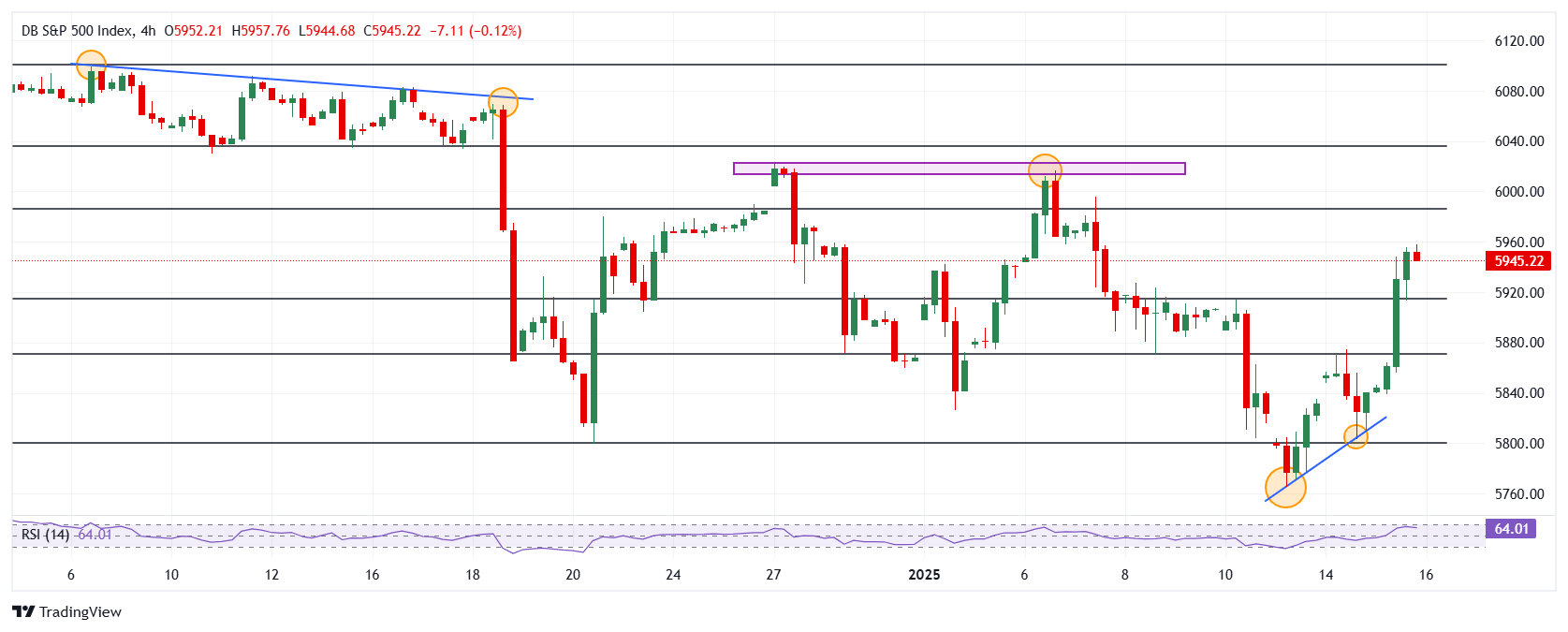- The S&P 500 stock index presents a gain of 1.80% on Wednesday, currently trading at 5,945.
- The Bank of New York Mellon (BK) rises 8.02% today, hitting six-week highs.
- Wells Fargo (CE) shares gain 5.37% on the day after releasing its earnings report.
- Citigroup (C) shares rose 6.49% daily, reaching highs in more than three and a half years at $79.25.
The S&P 500 hit a daily low of 5,839, drawing aggressive buyers who took the index to a more than one-week high of 5,996. Currently, the S&P 500 is trading above 5.945, gaining 1.80% on Wednesday.
Excellent reports from the banking sector encourage the S&P 500 into positive territory
The financial reporting season has begun with The Bank of New York Mellon (BK) reporting revenues of $4.85 billion, exceeding the $4.64 billion expected by consensus, as well as earnings per share of $1.54 versus the $1.51 projected. Following these results, BK presents a gain of 8.02%, reaching its highs of December 5 at $82.14.
In the same vein, Wells Fargo (WFC) shares gained 6.69% on the day, reaching December 2 highs of $76.82 after declaring revenues of $20.38 billion, slightly below the $20.49 billion dollars predicted by analysts. Similarly, WFC achieved earnings per share of $1.42, exceeding the $1.34 estimate.
On the other hand, Citigroup (C) shares reach a high not seen since June 10, 2021 at $79.25, rising 6.49% today. This rebound follows the publication of its earnings report, obtaining $19.58 billion in revenue, above $19.45 billion and an earnings per share of $1.34 compared to the $1.22 expected by the market.
In this context, the S&P 500 gains 1.80% today, visiting the highs of January 7 at 5,957.
Levels to consider in the S&P 500
The S&P 500 established short-term support given by the January 13 low at 5,765. To the north, the closest resistance is seen at 6.017, given by the January 6 high. The next key resistance is at 6,098, the December 6, 2024 pivot point.
S&P 500 4-hour chart

S&P 500 FAQs
The S&P 500 is a widely followed stock index that measures the performance of 500 public companies and is considered a broad measure of the US stock market. The influence of each company in the calculation of the index is weighted based on market capitalization. This is calculated by multiplying the number of listed shares of the company by the share price. The S&P 500 Index has achieved impressive returns: $1.00 invested in 1970 would have produced a return of almost $192.00 in 2022. The average annual return since its inception in 1957 has been 11.9%.
Companies are selected by committee, unlike other indices where they are included based on established standards. Still, they must meet certain eligibility criteria, the most important of which is market capitalization, which must be equal to or greater than $12.7 billion. Other criteria are liquidity, domicile, market capitalization, sector, financial viability, listing time, and representation of the sectors of the United States economy. The nine largest companies in the index represent 27.8% of the index’s market capitalization.
There are several ways to trade the S&P 500. Most retail brokers and spread betting platforms allow traders to use Contracts for Difference (CFDs) to place bets on price direction. In addition, you can buy index funds, mutual funds and exchange-traded funds (ETFs) that track the price of the S&P 500. The most liquid of the ETFs is the London Stock Exchange ETF. The most liquid of the ETFs is State Street Corporation’s SPY. The Chicago Mercantile Exchange (CME) offers futures contracts on the index and the Chicago Board of Options (CMOE) offers options, as well as ETFs, inverse ETFs, and leveraged ETFs.
There are many factors that drive the S&P 500, but primarily it is the aggregate performance of its component companies, revealed in their quarterly and annual earnings reports. US and global macroeconomic data also contribute, influencing investor sentiment, which if positive, drives earnings. The level of interest rates, set by the Federal Reserve (Fed), also influences the S&P 500, as it affects the cost of credit, on which many companies largely depend. Therefore, inflation can be a determining factor, as well as other parameters that influence the decisions of the Federal Reserve.
Source: Fx Street
I am Joshua Winder, a senior-level journalist and editor at World Stock Market. I specialize in covering news related to the stock market and economic trends. With more than 8 years of experience in this field, I have become an expert in financial reporting.







